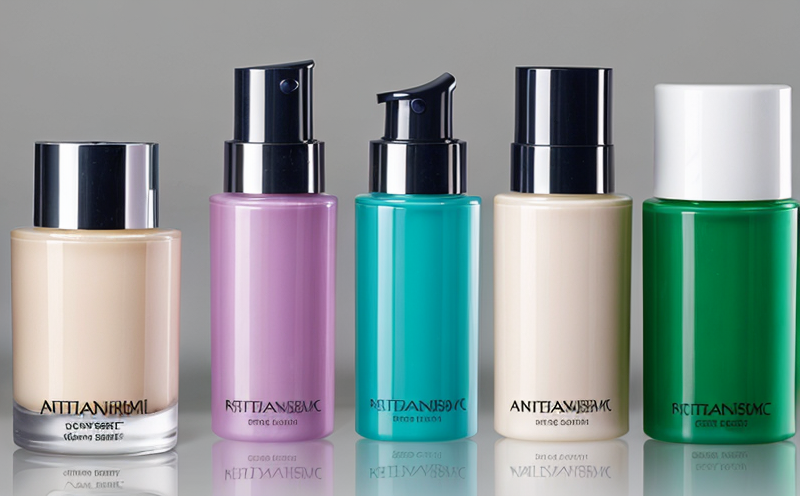Antimicrobial Resistance Risk Assessment in Cosmetics
The assessment of antimicrobial resistance (AMR) risk within cosmetics is a critical aspect of ensuring product safety and efficacy. AMR, which refers to the ability of microorganisms like bacteria to resist the effects of antibiotics or other antimicrobial agents, poses significant challenges for the cosmetic industry. This risk not only impacts public health but also affects consumer confidence in personal care products.
Microbial contamination can occur during various stages of cosmetics manufacturing and use, leading to potential AMR development. Cosmetics containing preservatives are designed to inhibit or kill microorganisms that may cause spoilage or degradation; however, the overuse or misuse of these agents could inadvertently promote resistance in targeted microbial populations. This necessitates rigorous testing protocols to evaluate both the efficacy and safety profile of preservative systems.
One common approach is to conduct antimicrobial susceptibility tests (AST) according to international standards such as ISO 26311:2017, which provides guidance on methods for determining the minimum inhibitory concentration (MIC). These tests involve exposing selected strains of bacteria and fungi to increasing concentrations of preservatives until growth ceases. By monitoring how these organisms respond under different conditions, manufacturers can better understand potential risks associated with their products.
Another important consideration is evaluating the persistence of microorganisms after exposure to preservative treatments. This helps determine whether residual viable cells remain capable of causing infections or contributing further to AMR issues downstream in consumer use. Additionally, understanding how formulation pH levels interact with various antimicrobial agents plays a crucial role since changes can significantly influence activity.
For effective assessment, laboratories must possess state-of-the-art equipment and expertise. Our facility employs advanced spectrophotometers capable of measuring optical density changes indicative of bacterial growth patterns over time. Microscopes allow for detailed visualization of colony-forming units post-treatment. Furthermore, we utilize automated microbial analysis systems that streamline sample preparation while enhancing accuracy.
The data generated through these analyses informs decisions regarding ingredient selection and formulation optimization aimed at minimizing AMR emergence without compromising product stability or effectiveness. It also supports regulatory compliance efforts by providing robust evidence supporting safe use practices.
In summary, comprehensive antimicrobial resistance risk assessment is essential for developing high-quality cosmetic products that meet strict quality assurance standards while safeguarding public health interests. Through careful evaluation of preservative systems and their interactions within formulations, we contribute towards fostering sustainable innovation in the industry.
Why It Matters
The importance of assessing antimicrobial resistance risk in cosmetics cannot be overstated given its implications for both human health and environmental sustainability. On one hand, ensuring that our products do not inadvertently promote AMR is vital because it helps prevent the spread of multidrug-resistant pathogens which can lead to treatment failures in clinical settings.
On the other hand, reducing unnecessary use of aggressive antimicrobial agents contributes positively towards preserving natural ecosystems by decreasing selective pressures exerted upon soil and water bodies where wild flora & fauna naturally reside. Moreover, companies adopting proactive measures demonstrate their commitment to responsible stewardship which enhances brand reputation among eco-conscious consumers.
From an operational standpoint, adherence to stringent testing procedures ensures consistent product quality across global markets thereby reducing liability risks associated with recalls or lawsuits due to safety concerns. Furthermore, demonstrating leadership in this area can open doors to new business opportunities such as collaborations with governmental agencies promoting public health initiatives focused on combating AMR.
In essence, prioritizing antimicrobial resistance risk assessment aligns corporate goals with broader societal objectives fostering trust between industry stakeholders and end users alike.
Quality and Reliability Assurance
To ensure accurate results in our assessments, we adhere strictly to established international guidelines including ISO 17025 for quality management systems. This certification guarantees that all laboratory operations comply with internationally recognized standards ensuring reliability and reproducibility of findings.
We maintain strict quality control measures throughout every stage of testing from receipt of samples through final reporting. Each step is meticulously documented using electronic record keeping systems which allow us to trace back any discrepancies if needed. Regular internal audits conducted by qualified personnel further reinforce our commitment to maintaining highest standards.
Our experienced team comprises certified professionals who stay updated on latest developments within the field ensuring they possess current knowledge relevant to conducting these assessments effectively. Continuous training programs are implemented regularly to enhance skills and keep abreast with emerging trends.
In addition, we employ stringent validation protocols for all analytical methods used in our laboratory. Validation encompasses method accuracy, precision, linearity, and robustness among others. These rigorous checks help confirm that each test yields reliable outcomes consistently across multiple trials.
Competitive Advantage and Market Impact
In today’s competitive market place, demonstrating leadership in areas such as antimicrobial resistance risk assessment can provide significant advantages for cosmetic manufacturers. By implementing robust testing procedures early on during development stages, companies can identify potential issues before they become costly problems downstream.
This proactive approach allows firms to make informed decisions about ingredient selection and formulation adjustments ensuring optimal performance while minimizing adverse effects. It also enhances trust between stakeholders leading to stronger brand loyalty among consumers who appreciate transparency regarding product safety.
From a regulatory perspective, compliance with strict testing protocols not only helps avoid legal challenges but also opens up new opportunities for collaboration with government bodies focused on addressing AMR globally. Such partnerships can lead to joint initiatives aimed at raising awareness and promoting best practices within the industry.
The ability to offer comprehensive assessments tailored specifically towards individual product lines sets us apart from competitors offering generic solutions. This level of customization reflects our dedication to meeting diverse client needs across various segments of the market ranging from niche specialty brands to large multinational corporations.





